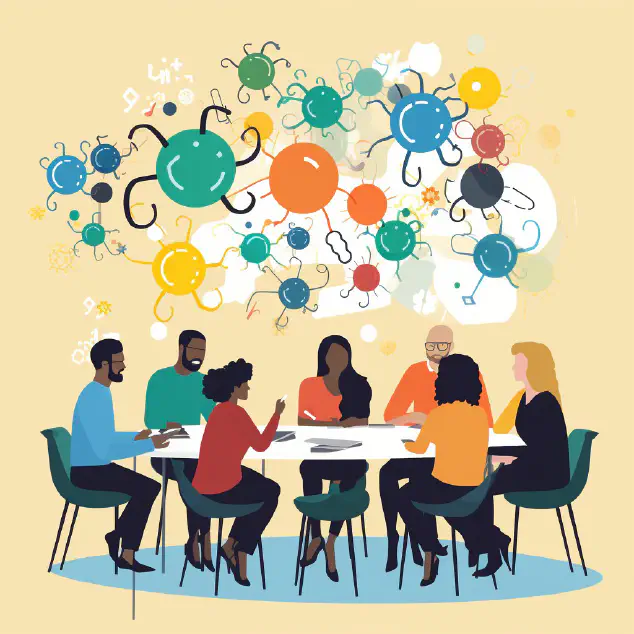
Introduction
Collaboration has become an essential component of today’s workplace, as it allows us to tap into the collective knowledge and idea-sharing capabilities of a group. However, simply working together is not enough; for truly effective collaboration, it is important to consider the benefits of diversity and incorporate a range of perspectives.
Definition of Diverse Perspectives
Diversity encompasses all the unique qualities and differences that people bring to the table, whether it be in terms of race, ethnicity, gender, age, religion, culture, work experience, educational background or socioeconomic status. Diverse perspectives refer to the varying viewpoints and insights that arise from these differences, each bringing valuable insights and new ways of thinking that enrich the collective decision-making process.
Importance of Collaborative Thinking
Collaborative thinking refers to a problem-solving approach that is characterized by shared knowledge, open communication and mutual respect. In this approach, diverse perspectives can bring fresh ideas and new perspectives to the table, leading to more innovative and inclusive solutions. When people with different backgrounds and experiences come together to work towards a common goal, they can challenge each other’s assumptions and generate new insights that they may not have uncovered on their own.
Thesis Statement
In short, diverse perspectives in collaborative thinking can lead to better outcomes, more inclusive solutions, and more creative problem-solving. With this in mind, it is crucial to recognize the importance of diverse perspectives in the workplace and make a conscious effort to incorporate them into our collaborations. This paper will explore the various benefits, challenges, and strategies associated with incorporating diverse perspectives in collaborative thinking, demonstrating how inclusive problem-solving practices can lead to success in the workplace.
Benefits of Diverse Perspectives in Collaborative Thinking
Collaborative thinking involves bringing together people from different backgrounds and experiences to work towards a common goal. When diverse perspectives are incorporated in collaborative thinking, several benefits arise, including:
Increased creativity and innovation
Incorporating diverse perspectives in collaborative thinking leads to a broader range of ideas, which in turn leads to new and innovative solutions. This is because people with different backgrounds and experiences are likely to approach problems differently, leading to fresh perspectives and ideas.
Improved problem-solving
When diverse perspectives are incorporated in collaborative thinking, problem-solving becomes more effective. This is because people approach problems differently, and incorporating diverse perspectives means that more factors are considered in the problem-solving process. As a result, potential blind spots are identified, leading to a more comprehensive solution.
Broader range of ideas
When people from diverse backgrounds collaborate, a wider range of ideas is generated. This leads to a better understanding of the problem at hand and a more comprehensive solution.
More inclusive solutions
Incorporating diverse perspectives in collaborative thinking leads to more inclusive solutions. This is because people from diverse backgrounds bring to the table different experiences, values, and beliefs. When these perspectives are considered, solutions are more likely to be inclusive and cater to the needs of a wider range of people.
Improved communication and teamwork
Collaborative thinking involves working together as a team towards a common goal. Incorporating diverse perspectives means that team members are exposed to different ways of communicating and working. As a result, communication and teamwork skills improve, leading to greater productivity and success.
Greater understanding and respect for differences
Incorporating diverse perspectives in collaborative thinking leads to a greater understanding and respect for differences. When people from different backgrounds come together, they are exposed to different beliefs, experiences, and values. This leads to greater empathy and a better understanding of different perspectives, leading to a more welcoming and inclusive environment.
Examples of Diverse Perspectives in Collaborative Thinking
Diversity in race, ethnicity, gender, age, religion, and culture
Collaborating with individuals from various racial, ethnic, and cultural backgrounds can bring different perspectives to the table and increase cultural awareness in the workplace. For example, a team of engineers developing a new product can benefit from hiring individuals from different ethnicities and cultures to understand the varied needs of the product’s potential consumers. When working with people of different ages, gender and religion, the team can gain new and unique insights into the project. The team will discover and embrace diverse ways of thinking and the different ways of looking at a problem.
Diversity in work experience and skills
Collaborating with individuals with different work experiences and skills can provide a fresh and exciting approach to problem-solving. For instance, healthcare professionals and engineers working together can develop better solutions for medical devices and equipment design. Having individuals with varying qualifications and experiences in the team ensures that the project’s problem is looked at through varied angles.
Diversity in educational background
Collaborating with individuals with a diverse educational background can lead to cross-pollination of ideas. For example, having an engineer and economist working together can bring unique insights into how a project can impact the economy, and with the knowledge of an engineer, they can create a technology that accommodates different aspects of the economy.
Diversity in social and economic status
Collaborating with individuals from different socio-economic backgrounds leads to better understanding; they can share different opinions and experiences that might not have been known, thereby creating an opportunity to handle and resolve social challenges. For example, a team of social workers, and engineers can collaborate to develop cost-effective and efficient solutions to provide rural communities with access to essential services such as electricity, hospitals, and clean water, ensuring that the community has a better quality of life.
Diverse perspectives enable better collaboration, resulting in increased creativity and innovation, improved problem-solving ability, and more inclusive solutions. Therefore, it is imperative to recognize and value diversity in collaborative thinking.
Challenges in Incorporating Diverse Perspectives
Incorporating diverse perspectives in collaborative thinking is not always easy. Bias, discrimination, and resistance to change can all present significant challenges. Understanding these challenges is essential for creating a more inclusive and innovative workplace.
Bias and Discrimination
One of the most significant challenges in incorporating diverse perspectives is bias and discrimination. Even when people are well-intentioned, unconscious bias can influence their decisions and limit their understanding of other people’s experiences. For example, a team leader might assume that male team members have more knowledge and expertise than female team members, even if this is not the case. To overcome bias and discrimination, it’s essential to create a culture of inclusion that values diverse perspectives and promotes equality.
Stereotypes and Assumptions
Stereotypes and assumptions are another challenge to incorporating diverse perspectives. People often make assumptions based on stereotypes rather than taking the time to understand different perspectives. For example, a manager might assume that someone who immigrated from a different country doesn’t have the same knowledge and expertise as someone who was born and raised in the company’s home country. To overcome stereotypes and assumptions, it’s essential to recognize and challenge them and actively seek out different perspectives.
Lack of Representation
Lack of representation is another significant challenge to incorporating diverse perspectives. When certain groups are underrepresented in a team or workplace, their perspectives and experiences are often overlooked. For example, if a team only includes people from a specific ethnic group, the team might not consider how their decisions might impact people from other ethnic groups. To overcome the lack of representation, it’s essential to actively seek out diverse perspectives and ensure that everyone has a voice in the decision-making process.
Resistance to Change
Resistance to change is also a significant challenge to incorporating diverse perspectives. Some people might be resistant to incorporating diverse perspectives because they are afraid of change or because they believe they are already doing things the right way. For example, a team might resist incorporating diverse perspectives because they believe their current approach is already successful. To overcome resistance to change, it’s essential to create a culture of inclusion that values different perspectives and promotes openness to new ideas.
In conclusion, incorporating diverse perspectives in collaborative thinking is essential for creating innovative and inclusive solutions. However, challenges like bias and discrimination, stereotypes and assumptions, lack of representation, and resistance to change can make it difficult to do so. To overcome these challenges, it’s essential to create a culture of inclusion, actively seek out diverse perspectives, and challenge assumptions and biases. By embracing diverse perspectives, we can create a more innovative, productive, and equitable workplace.
Strategies for Incorporating Diverse Perspectives
Incorporating diverse perspectives is not always easy, but it is essential to creating more innovative and inclusive solutions. Here are some strategies to help you incorporate diverse perspectives in collaborative thinking:
Creating a culture of inclusion
Creating a culture of inclusion means making everyone feel valued and respected. This means creating an environment where everyone feels comfortable sharing their thoughts and ideas. One way to do this is by encouraging team members to share their experiences and perspectives. You can also create a code of conduct that outlines expectations for how team members should interact with one another.
Actively seeking out diverse perspectives
Actively seeking out diverse perspectives means going beyond the usual suspects and reaching out to people who may have different experiences and perspectives. This means reaching out to people who may be outside of your usual network, such as people from different backgrounds, cultures, or industries. You can also look for experts in different fields and invite them to share their perspectives.
Encouraging open communication and feedback
Encouraging open communication and feedback means creating an environment where everyone feels comfortable sharing their thoughts and ideas. This means creating a safe space where people can express their thoughts without fear of judgment or retribution. You can also create opportunities for feedback, such as regular team meetings, surveys, or one-on-one sessions with team members.
Challenging assumptions and biases
Challenging assumptions and biases means questioning your own assumptions and biases, as well as those of others. This means being aware of your own biases and actively working to overcome them. It also means being open to feedback and criticism, and using it to improve yourself and your work.
Providing diverse training and resources
Providing diverse training and resources means giving team members the tools they need to understand and appreciate diversity. This could include training on topics such as unconscious bias, inclusive leadership, and effective communication. It could also mean providing resources such as books, articles, and videos that explore different perspectives and experiences.
By incorporating these strategies, you can create a more inclusive and innovative work environment that values diverse perspectives.
Conclusion
In conclusion, diverse perspectives in collaborative thinking are vital for creating innovative and inclusive solutions. By incorporating inputs from individuals with different backgrounds and experiences, we open up opportunities for fresh ideas and unique solutions to complex problems. Leveraging diverse perspectives brings about a broader range of ideas, promotes creativity, and leads to better problem-solving.
However, it is essential to note that there are challenges in incorporating diverse perspectives, such as bias, discrimination, and stereotypes. To overcome these barriers, we must create a culture of inclusion and actively seek out diverse perspectives. Open communication, challenging assumptions, and providing diverse training and resources can also be effective strategies for incorporating different perspectives.
In the end, embracing diverse perspectives in collaborative thinking is critical for creating a socially and economically just society. Diversity in race, ethnicity, gender, age, religion, culture, work experience, skills, and education can significantly contribute to a more inclusive and innovative society. Therefore, it is necessary to recognize the importance of collaborative thinking and diverse perspectives in creating sustainable solutions for a better future.



